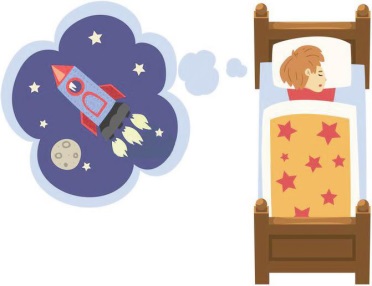individuals can act out their dreams. Shouting, kicking or more complex behaviors can manifest. This poses a significant potential safety risk as someone completely asleep and unaware of their behavior can walk out of a window, walk into the road or injure others in fight/flight dreams. REM-sleep behaviors are commonly seen as a symptom of Parkinson's Disease, but it can also occur on its own. Loved ones can be injured when someone with sleep behavior is shouting and striking out in sleep occurs. REM-sleep behavior disorder can be treated with a benzodiazepine such as clonazepam before bed. 8
The fact that we are able to easily demonstrate that these behaviors occur during REM sleep provides some powerful evidence to support the hypothesis that dreaming occurs during REM sleep, especially since we see REM sleep-behavior can be complex. However, sleep behavior isn't limited to REM sleep. Some parasomnias occur during NREM sleep. These NREM parasomnias have a variety of causes and contributors, including genetic predisposition and triggers such as obstructive sleep apnea or leg movements.
Most widely known among the non-REM sleep disorders is sleepwalking or somnambulation, which can be accompanied by complex behaviors, even with driving a car. Somnambulation can occur in both children and adults. Good sleep habits are a first-line treatment for non-REM sleep behaviors, but medications such as benzodiazepines or antidepressants may sometimes be needed. Another of the NREM sleep disorders, sleep-related eating disorder, may be associated with sleep medications. such as zolpidem (brand name Ambien) or eszopiclone (brand name Lunesta), and either medication can rarely lead to the curious phenomenon of awakening in the morning to find that half of the contents of the refrigerator have been eaten.
A non-REM sleep disorder of childhood is known as sleep Terrors, a frightening thing for parents who are helping their children get through them. Night terrors are distinct from nightmares. Children will appear to be awake, but are in fact in deltaNREM sleep, the deepest phase of sleep. They will open their eyes and without warning can scream and cry uncontrollably, with parents unable to console or awaken them. Children invariably have no memory of the episodes and treatment involves lots of reassurance and support for understandably traumatized parents along with a regular sleep schedule. Fortunately, night terrors don't last into adulthood and go away on their own. However, episodes of sudden night time terror are also seen in PTSD and in the setting of trauma. If a loved one is awakening with night terror-like experiences, it is important to screen for actual nightmares and trauma, or PTSD among the adolescents and adults with intellectual or developmental disabilities. 9
Some people can be bothered by sudden, rapid muscle contractions can occur upon falling asleep. These movements, called hypnic jerks, are sudden muscle contractions that can look like seizures, but they are a benign phenomenon that can be treated with reassurance. Some people will have periodic movements of their arms or legs that can look like seizures while they are sleeping, a disorder called Periodic Limb Movement Disorder, or PLMD, also called Periodic Limb Movements of Sleep or PLMS. People with PLMD will rhythmically and sometimes violently move their arms or legs while they sleep, often awakening loved ones and sometimes awakening themselves. 10
Apart from motor function, a cognitive and sensory disconnection occurs in sleep. Our senses are muted to an extent on falling asleep, and then sight, hearing and touch come back fully online upon awakening. While we are asleep, we are not usually aware of the process and we are a very unique and special kind of unconscious – we are not aware of the outside world but can be aroused by intense input in any sensory modality. During this period, our senses are relatively disconnected and we are free to dream. Two mysterious parasomnias involve dysregulation of that sensory dampening. Sometimes, we can have dream intrusions into our waking world, where we can have complex hallucinations hearing and seeing things that aren’t there while we are drifting off or awakening. When they occur during the transition to sleep, they are called hypnogogic hallucinations, and on the transition to waking they are called hypnopompic hallucinations.

"With the limits of our ability to quantitatively and objectively study our dreams, we may find meaning in the subjective, personal and unique stories when we remember them."
One of the most dramatically named hypnogogic parasomnias is the Exploding Head Syndrome (I promise, that’s a real thing), which is characterized by a sudden and loud sound, often described as metallic, upon falling asleep or shortly thereafter, and which is often evaluated as a potentially serious headache but which is in fact a sleep disorder. 11
Among people with intellectual and developmental disabilities, reports of hallucinations need to be very carefully evaluated. In the general population, illnesses that are associated with hallucinations fall into potentially narrower categories than amongst people with I/DD. In addition to sleep disorders, auditory hallucinations are more commonly associated with many types of schizophrenia. Visual hallucinations are less common but are seen in vision loss (called Charles Bonnet Syndrome), in Parkinson's Disease and related syndromes. Tactile hallucinations are very common in many types of substance withdrawal and are seen in delirium. Olfactory (scents and odors) and gustatory (taste) hallucinations are hallmarks of many types of seizures. Evaluating complex hallucinations, or hallucinations that are experienced in more than one sensory mode, takes extra time and care.
In working with people with developmental disabilities, it is not uncommon for caregivers to seek neurologic or psychiatric evaluation when an individual with I/DD is seen to have interactions or